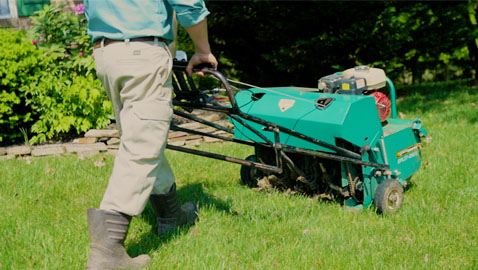Lawn Care for Beginners [A Guide for New Homeowners]
Last updated: 10/14/2021
Estimated read time: 6 minutes
So you’re a new homeowner. Congratulations! You’re standing at the curb, looking at your brand new house with pride when it hits you, you have absolutely no idea how to care for a yard. Panicking now, you think to yourself, “Help, I just bought a house, what do I do for my lawn?” There’s good news though. With the right knowledge and an organized plan, caring for your lawn is easy—even for a beginner. And at Blades of Green, we’re here to help you get started.

Mowing
Mowing your lawn seems like the simplest task imaginable. When the grass gets too tall, you just cut it, right? Well, in reality, there’s a bit more to it than that. Mowing is just as much a science as it is an art, and there are a few things to be mindful of, including:
Grass Height
Every quality lawnmower has adjustable blades, meaning that you can manually set their height. For optimal results that stimulate full and healthy growth without stressing your lawn, set your blades to cut no more than ⅓ of your grass’ overall height. Aim to keep tall fescue grass between 3.5″-4″ tall. Also, for best results, mow in a different direction than the last cutting. This helps to prevent ruts from forming and helps your grass maintain a healthy, upright position.
Cleanup
Unless your grass is suffering from a fungus, it is a good idea to leave your clippings on the lawn. This provides free nutrients and water for your soil. If you haven’t mowed in quite some time and have grown out fescue, you may want to bag part or all of your clippings for the first cut. As the weather turns cooler, make sure you are keeping your lawn free from leaves, branches, and sticks.
Mower maintenance:
Just like any tool, your lawnmower needs to be maintained. Above all else, we recommend cleaning your mower’s undercarriage after each use, focusing on the blade in particular (carefully, of course). A sharp blade cuts grass cleanly while a dull blade pulls at the grass’ stems, causing unnecessary stress to the plant and creating an unattractive appearance.
Timing
Timing matters when it comes to mowing your lawn. Ideally, you should be cutting your grass between 8:00 and 10:00 AM, giving it time to recover before the heat of the afternoon sets in. Also, you don’t want to mow just after watering. You’ll know that your lawn is ready when you can walk across it and your shoes don’t get wet.

Aerating and Seeding
Over the course of a year, it’s natural for soil to become compacted and for a certain percentage of your grass to die off. Performed together, aeration and seeding solve both of these problems, with numerous benefits to your lawn, including:
- Increased oxygen levels in your soil.
- Easier access to water and nutrients.
- A reduction in standing water levels, which helps prevent disease and fungus.
- Thicker growth, which allows your grass to outcompete weeds.
- A healthier, more lush appearance.
Combined, aeration and seeding can have a drastic impact on your lawn and luckily, this service can be done yourself. If you’re new to lawn care though, we recommend booking professional service until you’re more confident in your abilities.

Fertilizing
Even the healthiest soil needs a boost from time to time. No matter how healthy your lawn’s soil is, it will naturally become nutrient-deficient over time, which is exactly where fertilizers can help. Before applying any fertilizer to your grass though, consult a professional who can conduct a quality soil test. Testing the soil will paint a clear picture of your lawn’s nutritional needs and help your technician recommend seasonally adjusted treatments. When fertilizing, however, it is important to exercise restraint. Excess fertilizer use will throw your lawn’s delicate chemical balance off and can even trigger fungal outbreaks.
Weed Control
Weeds are among the most visible yard nuisances, and when left alone, are one of the most overwhelming. Simply put, a weed is any undesirable plant that grows where you don’t want it to. Characteristic to their reputation though, most weeds spread aggressively and grow quickly, robbing desired plants of growing space, nutrients, and water. DIY weed control can be as simple as pulling them up whenever they appear. However, that is rarely an effective long-term solution and often simply delays an infestation rather than stopping one. Instead, we recommend professional maintenance and targeted herbicide application.
A few of the most common weeds in the Mid-Atlantic include:
- Bittercress
- Buttercups
- Chickweed
- Clover
- Crabgrass
- Dandelions
- Henbit
- Spotted Spurge
Lawn Care FAQ
Caring for your lawn can be daunting, but once you’re comfortable, it can also be an exciting and fulfilling exercise in creative expression. Still, we completely understand that you’ll have questions. Here are a few of the most common ones that we encounter on a daily basis and will help you take the first steps.
When Should I Start Working on my Lawn?
In our temperate Mid-Atlantic climate, late February and early March are the ideal times to begin working on your lawn. During this window of time, the temperature is rising and your lawn is waking up from its winter hibernation. Taking advantage of the transition between winter and spring gives your lawn a nice boost but helps you stay a step ahead of its peak activity.
What Month is Best to Put Grass Seed Down?
You can seed your lawn anytime but generally, it has the greatest effect when done in late September or early October. Seeding in fall will result in fresh new growth come spring, giving your lawn a full and healthy appearance right away. When done in conjunction with aeration, autumn seeding is even more effective.
What Lawn Care Equipment Do I Need?
Caring for your lawn requires tools. But while it’s easy to get carried away, buying top-of-the-line equipment with professional features that you’ll never use, that’s far from necessary. Truthfully, you can get an outstanding lawn with a few simple tools, including a:
- Lawnmower
- Leaf and soil rakes
- Snow shovel
- Long-handled spade shovel
- Handheld clippers
- Hedge trimmers
- Hose
As with so many other things, you get what you pay for when it comes to lawn care equipment. There’s no need to spend top dollar on any one tool but be aware that high-quality gear will last longer and work better. Our advice is to spend a little more now to save quite a bit more later.
Final Thought
Above all else, caring for your lawn should be rewarding. A well-maintained yard is something that you should feel proud of and be able to enjoy for years to come. We know that getting started can be intimidating but hopefully, we’ve answered some of your most pressing questions and armed you with the knowledge that you need to get started!
If you have further questions or are interested in our lawn care services, please contact our team of local experts.
Have a Question About Lawn Care? Ask the Experts!
Having a lawn care problem that you can’t seem to solve? Send your question to our expert technicians and get the answers you need to get a healthy, beautiful lawn.
Ask a Lawn Care QuestionConsider Professional Lawn Care
End the guesswork and stress of lawn maintenance. Let our experienced team put their expertise to work making your lawn healthy and beautiful.
Get a FREE Lawn Care Quote Now
Quick Quote Form
"*" indicates required fields
